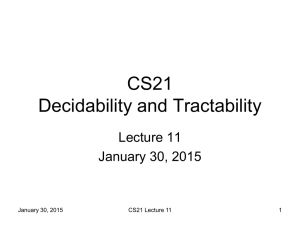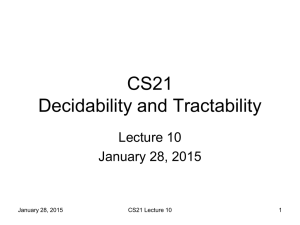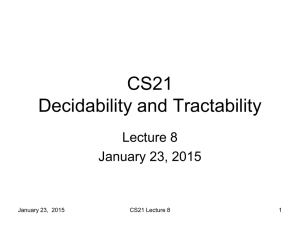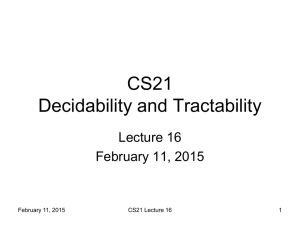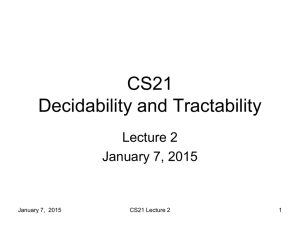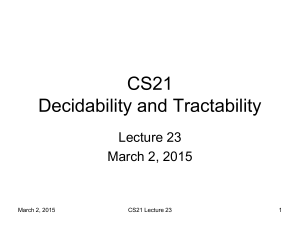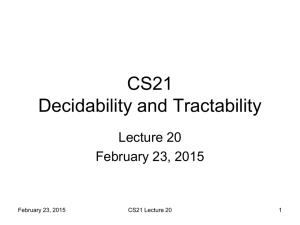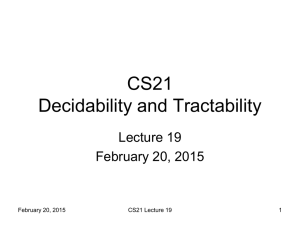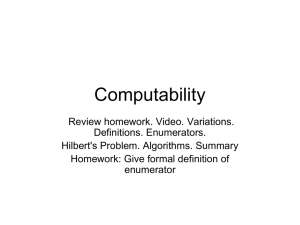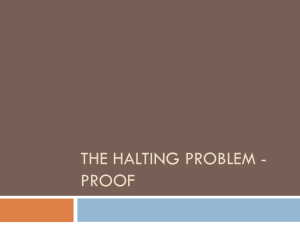ppt
advertisement
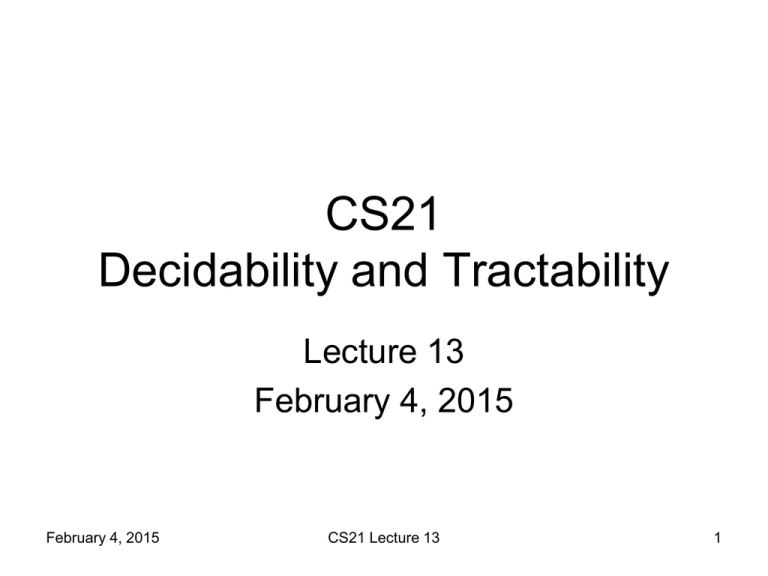
CS21
Decidability and Tractability
Lecture 13
February 4, 2015
February 4, 2015
CS21 Lecture 13
1
Outline
•
many-one reductions
•
undecidable problems
–
–
•
computation histories
surprising contrasts between
decidable/undecidable
Rice’s Theorem
February 4, 2015
CS21 Lecture 13
2
Definition of reduction
• Can you reduce co-HALT to HALT?
• We know that HALT is RE
• Does this show that co-HALT is RE?
– recall, we showed co-HALT is not RE
• our current notion of reduction cannot
distinguish complements
February 4, 2015
CS21 Lecture 13
3
Definition of reduction
• More refined notion of reduction:
– “many-one” reduction (commonly)
– “mapping” reduction (book)
A
yes
no
February 4, 2015
f
f
B
yes
no
CS21 Lecture 13
reduction from
language A to
language B
4
Definition of reduction
A
yes
no
f
f
B
yes
no
• function f should be computable
Definition: f : Σ*→ Σ* is computable if there
exists a TM Mf such that on every wΣ* Mf
halts on w with f(w) written on its tape.
February 4, 2015
CS21 Lecture 13
5
Definition of reduction
• Notation: “A many-one reduces to B” is
written
A ≤m B
– “yes maps to yes and no maps to no” means:
w A maps to f(w) B & w A maps to f(w) B
• B is at least as “hard” as A
– more accurate: B at least as “expressive” as A
February 4, 2015
CS21 Lecture 13
6
Using reductions
Definition: A ≤m B if there is a computable
function f such that for all w
w A f(w) B
Theorem: if A ≤m B and B is decidable then
A is decidable
Proof:
– decider for A: on input w, compute f(w), run
decider for B, do whatever it does.
February 4, 2015
CS21 Lecture 13
7
Using reductions
• Main use: given language NEW, prove it is
undecidable by showing OLD ≤m NEW,
where OLD known to be undecidable
– proof by contradiction
– if NEW decidable, then OLD decidable
– OLD undecidable. Contradiction.
• common to reduce in wrong direction.
• review this argument to check yourself.
February 4, 2015
CS21 Lecture 13
8
Using reductions
Theorem: if A ≤m B and B is RE then A is
RE
Proof:
– TM for recognizing A: on input w, compute
f(w), run TM that recognizes B, do whatever it
does.
• Main use: given language NEW, prove it is
not RE by showing OLD ≤m NEW, where
OLD known to be not RE.
February 4, 2015
CS21 Lecture 13
9
Many-one reduction example
• Showed ETM undecidable. Consider:
co-ETM = {<M> : L(M) Ø}
yes
no
ATM
February 4, 2015
f
f
yes
no
co-ETM
• f(<M, w>) = <M’>
where M’ is TM that
• on input x, if x w,
then reject
• else simulate M on x,
and accept if M does
• f clearly computable
CS21 Lecture 13
10
Many-one reduction example
yes
no
ATM
f
f
yes
no
co-ETM
• yes maps to yes?
• f(<M, w>) = <M’>
where M’ is TM that
• on input x, if x w,
then reject
• else simulate M on x,
and accept if M does
• f clearly computable
– if <M, w> ATM then f(M, w) co-ETM
• no maps to no?
– if <M, w> ATM then f(M, w) co-ETM
February 4, 2015
CS21 Lecture 13
11
Undecidable problems
Theorem: The language
REGULAR = {<M>: M is a TM and L(M) is
regular}
is undecidable.
Proof:
– reduce from ATM (i.e. show ATM ≤m REGULAR)
– what should f(<M, w>) produce?
February 4, 2015
CS21 Lecture 13
12
Undecidable problems
Proof:
– f(<M, w>) = <M’> described below
on input x:
• is f computable?
• if x has form 0n1n, accept
• YES maps to YES?
• else simulate M on w
and accept x if M accepts
<M, w> ATM
f(M, w) REGULAR
• NO maps to NO?
<M, w> ATM
f(M, w) REGULAR
February 4, 2015
CS21 Lecture 13
13
Dec. and undec. problems
• the boundary between decidability and
undecidability is often quite delicate
– seemingly related problems
– one decidable
– other undecidable
• We will see two examples of this
phenomenon next.
February 4, 2015
CS21 Lecture 13
14
Computation histories
• Recall configuration of a TM: string uqv
with u,v *, q Q
• The sequence of configurations M goes
through on input w is a computation
history of M on input w
– may be accepting, or rejecting
– reserve the term for halting computations
– nondeterministic machines may have several
computation histories for a given input.
February 4, 2015
CS21 Lecture 13
15
Linear Bounded Automata
LBA definition: TM that is prohibited from
moving head off right side of input.
– machine prevents such a move, just like a TM
prevents a move off left of tape
• How many possible configurations for a
LBA M on input w with |w| = n, m states,
and p = || ?
– counting gives: mnpn
February 4, 2015
CS21 Lecture 13
16
Dec. and undec. problems
• two problems we have seen with respect
to TMs, now regarding LBAs:
– LBA acceptance:
ALBA = {<M, w> : LBA M accepts input w}
– LBA emptiness:
ELBA = {<M> : LBA M has L(M) = Ø}
• Both decidable? both undecidable? one
decidable?
February 4, 2015
CS21 Lecture 13
17
Dec. and undec. problems
Theorem: ALBA is decidable.
Proof:
– input <M, w> where M is a LBA
– key: only mnpn configurations
– if M hasn’t halted after this many steps, it
must be looping forever.
– simulate M for mnpn steps
– if it halts, accept or reject accordingly,
– else reject since it must be looping
February 4, 2015
CS21 Lecture 13
18
Dec. and undec. problems
Theorem: ELBA is undecidable.
Proof:
– reduce from co-ATM (i.e. show co-ATM ≤m ELBA)
– what should f(<M, w>) produce?
– Idea:
• produce LBA B that accepts exactly the accepting
computation histories of M on input w
February 4, 2015
CS21 Lecture 13
19
Dec. and undec. problems
Proof:
– f(<M, w>) = <B> described below
on input x, check if x has form
#C1#C2#C3#...#Ck#
• check that C1 is the start
configuration for M on input w
• check that Ci1 Ci+1
• check that Ck is an accepting
configuration for M
February 4, 2015
CS21 Lecture 13
• is B an LBA?
• is f computable?
• YES maps to YES?
<M, w> co-ATM
f(M, w) ELBA
• NO maps to NO?
<M, w> co-ATM
f(M, w) ELBA
20
Dec. and undec. problems
• two problems regarding Context-Free
Grammars:
– does a CFG generate all strings:
ALLCFG = {<G> : G is a CFG and L(G) = Σ*}
– CFG emptiness:
ECFG = {<G> : G is a CFG and L(G) = Ø}
• Both decidable? both undecidable? one
decidable?
February 4, 2015
CS21 Lecture 13
21
